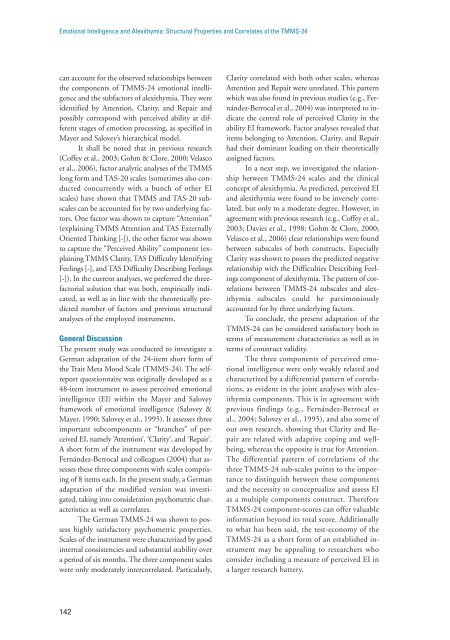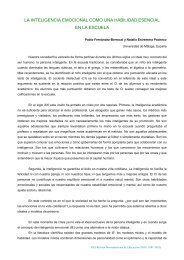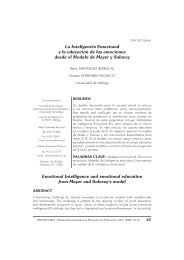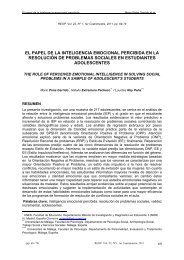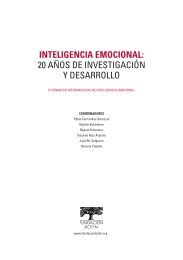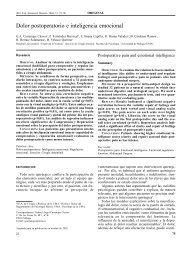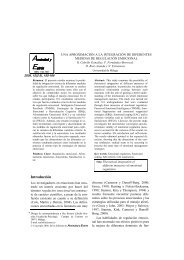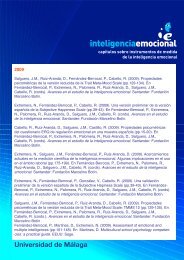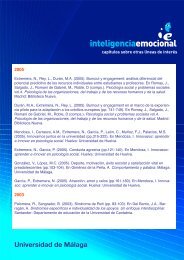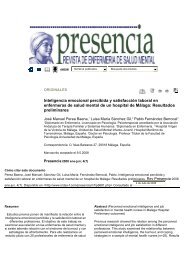Avances en el estudio de la Inteligencia Emocional
Avances en el estudio de la Inteligencia Emocional
Avances en el estudio de la Inteligencia Emocional
Create successful ePaper yourself
Turn your PDF publications into a flip-book with our unique Google optimized e-Paper software.
Emotional Int<strong>el</strong>lig<strong>en</strong>ce and Alexithymia: Structural Properties and Corr<strong>el</strong>ates of the TMMS-24<br />
can account for the observed r<strong>el</strong>ationships betwe<strong>en</strong><br />
the compon<strong>en</strong>ts of TMMS-24 emotional int<strong>el</strong>lig<strong>en</strong>ce<br />
and the subfactors of alexithymia. They were<br />
id<strong>en</strong>tified by Att<strong>en</strong>tion, C<strong>la</strong>rity, and Repair and<br />
possibly correspond with perceived ability at differ<strong>en</strong>t<br />
stages of emotion processing, as specified in<br />
Mayer and Salovey’s hierarchical mod<strong>el</strong>.<br />
It shall be noted that in previous research<br />
(Coffey et al., 2003; Gohm & Clore, 2000; V<strong>el</strong>asco<br />
et al., 2006), factor analytic analyses of the TMMS<br />
long form and TAS-20 scales (sometimes also conducted<br />
concurr<strong>en</strong>tly with a bunch of other EI<br />
scales) have shown that TMMS and TAS-20 subscales<br />
can be accounted for by two un<strong>de</strong>rlying factors.<br />
One factor was shown to capture “Att<strong>en</strong>tion”<br />
(exp<strong>la</strong>ining TMMS Att<strong>en</strong>tion and TAS Externally<br />
Ori<strong>en</strong>ted Thinking [-]), the other factor was shown<br />
to capture the “Perceived Ability” compon<strong>en</strong>t (exp<strong>la</strong>ining<br />
TMMS C<strong>la</strong>rity, TAS Difficulty Id<strong>en</strong>tifying<br />
Fe<strong>el</strong>ings [-], and TAS Difficulty Describing Fe<strong>el</strong>ings<br />
[-]). In the curr<strong>en</strong>t analyses, we preferred the threefactorial<br />
solution that was both, empirically indicated,<br />
as w<strong>el</strong>l as in line with the theoretically predicted<br />
number of factors and previous structural<br />
analyses of the employed instrum<strong>en</strong>ts.<br />
G<strong>en</strong>eral Discussion<br />
The pres<strong>en</strong>t study was conducted to investigate a<br />
German adaptation of the 24-item short form of<br />
the Trait Meta Mood Scale (TMMS-24). The s<strong>el</strong>freport<br />
questionnaire was originally <strong>de</strong>v<strong>el</strong>oped as a<br />
48-item instrum<strong>en</strong>t to assess perceived emotional<br />
int<strong>el</strong>lig<strong>en</strong>ce (EI) within the Mayer and Salovey<br />
framework of emotional int<strong>el</strong>lig<strong>en</strong>ce (Salovey &<br />
Mayer, 1990; Salovey et al., 1995). It assesses three<br />
important subcompon<strong>en</strong>ts or “branches” of perceived<br />
EI, nam<strong>el</strong>y ‘Att<strong>en</strong>tion’, ‘C<strong>la</strong>rity’, and ‘Repair’.<br />
A short form of the instrum<strong>en</strong>t was <strong>de</strong>v<strong>el</strong>oped by<br />
Fernán<strong>de</strong>z-Berrocal and colleagues (2004) that assesses<br />
these three compon<strong>en</strong>ts with scales comprising<br />
of 8 items each. In the pres<strong>en</strong>t study, a German<br />
adaptation of the modified version was investigated,<br />
taking into consi<strong>de</strong>ration psychometric characteristics<br />
as w<strong>el</strong>l as corr<strong>el</strong>ates.<br />
The German TMMS-24 was shown to possess<br />
highly satisfactory psychometric properties.<br />
Scales of the instrum<strong>en</strong>t were characterized by good<br />
internal consist<strong>en</strong>cies and substantial stability over<br />
a period of six months. The three compon<strong>en</strong>t scales<br />
were only mo<strong>de</strong>rat<strong>el</strong>y intercorr<strong>el</strong>ated. Particu<strong>la</strong>rly,<br />
C<strong>la</strong>rity corr<strong>el</strong>ated with both other scales, whereas<br />
Att<strong>en</strong>tion and Repair were unr<strong>el</strong>ated. This pattern<br />
which was also found in previous studies (e.g., Fernán<strong>de</strong>z-Berrocal<br />
et al., 2004) was interpreted to indicate<br />
the c<strong>en</strong>tral role of perceived C<strong>la</strong>rity in the<br />
ability EI framework. Factor analyses revealed that<br />
items b<strong>el</strong>onging to Att<strong>en</strong>tion, C<strong>la</strong>rity, and Repair<br />
had their dominant loading on their theoretically<br />
assigned factors.<br />
In a next step, we investigated the r<strong>el</strong>ationship<br />
betwe<strong>en</strong> TMMS-24 scales and the clinical<br />
concept of alexithymia. As predicted, perceived EI<br />
and alexithymia were found to be invers<strong>el</strong>y corr<strong>el</strong>ated,<br />
but only to a mo<strong>de</strong>rate <strong>de</strong>gree. However, in<br />
agreem<strong>en</strong>t with previous research (e.g., Coffey et al.,<br />
2003; Davies et al., 1998; Gohm & Clore, 2000;<br />
V<strong>el</strong>asco et al., 2006) clear r<strong>el</strong>ationships were found<br />
betwe<strong>en</strong> subscales of both constructs. Especially<br />
C<strong>la</strong>rity was shown to posses the predicted negative<br />
r<strong>el</strong>ationship with the Difficulties Describing Fe<strong>el</strong>ings<br />
compon<strong>en</strong>t of alexithymia. The pattern of corr<strong>el</strong>ations<br />
betwe<strong>en</strong> TMMS-24 subscales and alexithymia<br />
subscales could be parsimoniously<br />
accounted for by three un<strong>de</strong>rlying factors.<br />
To conclu<strong>de</strong>, the pres<strong>en</strong>t adaptation of the<br />
TMMS-24 can be consi<strong>de</strong>red satisfactory both in<br />
terms of measurem<strong>en</strong>t characteristics as w<strong>el</strong>l as in<br />
terms of construct validity.<br />
The three compon<strong>en</strong>ts of perceived emotional<br />
int<strong>el</strong>lig<strong>en</strong>ce were only weakly r<strong>el</strong>ated and<br />
characterized by a differ<strong>en</strong>tial pattern of corr<strong>el</strong>ations,<br />
as evid<strong>en</strong>t in the joint analyses with alexithymia<br />
compon<strong>en</strong>ts. This is in agreem<strong>en</strong>t with<br />
previous findings (e.g., Fernán<strong>de</strong>z-Berrocal et<br />
al., 2004; Salovey et al., 1995), and also some of<br />
our own research, showing that C<strong>la</strong>rity and Repair<br />
are r<strong>el</strong>ated with adaptive coping and w<strong>el</strong>lbeing,<br />
whereas the opposite is true for Att<strong>en</strong>tion.<br />
The differ<strong>en</strong>tial pattern of corr<strong>el</strong>ations of the<br />
three TMMS-24 sub-scales points to the importance<br />
to distinguish betwe<strong>en</strong> these compon<strong>en</strong>ts<br />
and the necessity to conceptualize and assess EI<br />
as a multiple compon<strong>en</strong>ts construct. Therefore<br />
TMMS-24 compon<strong>en</strong>t-scores can offer valuable<br />
information beyond its total score. Additionally<br />
to what has be<strong>en</strong> said, the test-economy of the<br />
TMMS-24 as a short form of an established instrum<strong>en</strong>t<br />
may be appealing to researchers who<br />
consi<strong>de</strong>r including a measure of perceived EI in<br />
a <strong>la</strong>rger research battery.<br />
142


